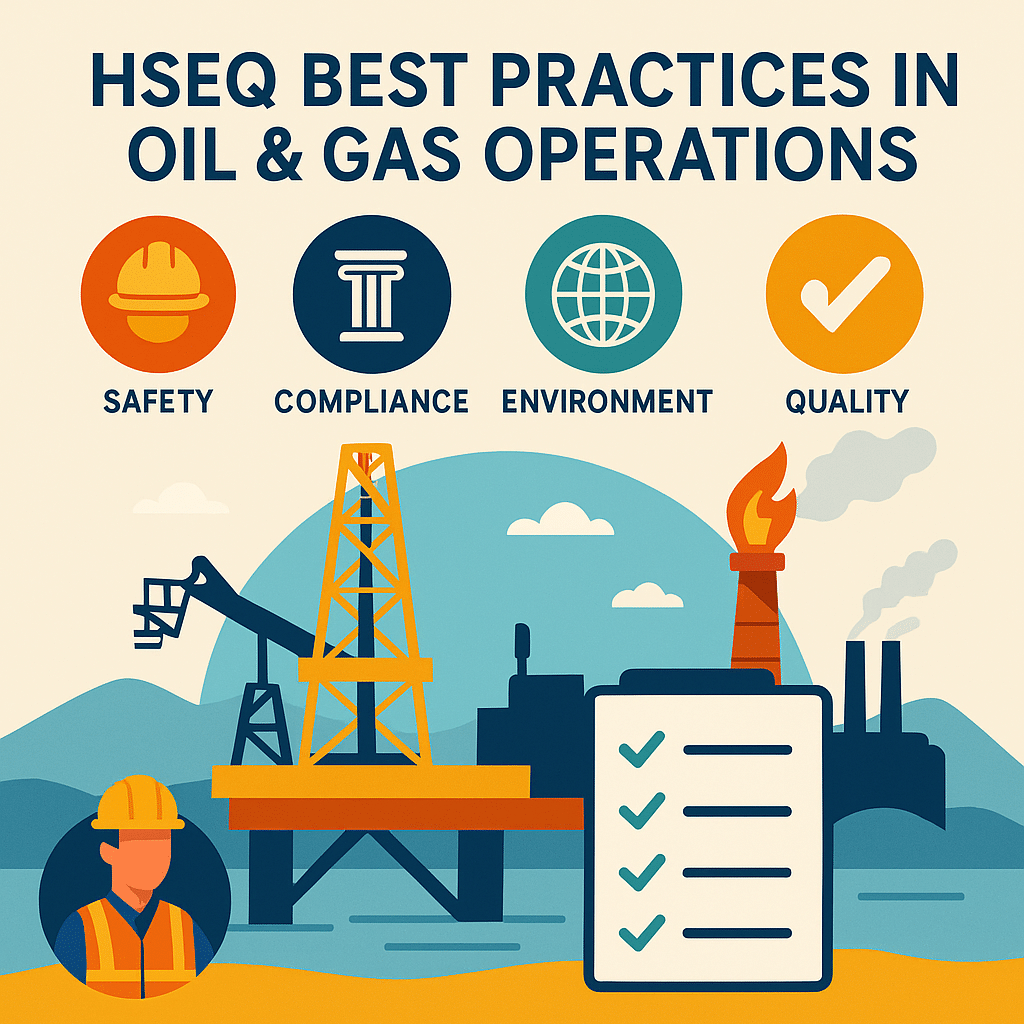HSEQ Best Practices in Oil & Gas Operations begin with one fundamental goal—managing high-risk environments without compromising safety, environmental integrity, or operational efficiency.
In the oil and gas sector, where the stakes are extreme, robust Health, Safety, Environment, and Quality (HSEQ) strategies are not optional—they’re mission-critical.

This article breaks down how leading companies integrate HSEQ best practices across upstream, midstream, and downstream activities to ensure regulatory compliance, mitigate risk, and promote a culture of safety excellence.
Why HSEQ Matters in Oil & Gas Operations
The oil and gas industry operates in some of the most hazardous environments on the planet—from deep-sea rigs to remote deserts. These environments present serious risks:
- Explosions and fires
- Toxic gas releases (e.g., H2S)
- Environmental spills
- Mechanical failures
- Worker injuries and fatalities
By embedding HSEQ best practices, organizations can prevent catastrophic incidents, reduce downtime, and demonstrate responsible stewardship of both human and environmental resources.
🔗 For incident data and safety stats, visit the International Association of Oil & Gas Producers (IOGP) (DoFollow link)
Key HSEQ Best Practices in Oil & Gas Operations
1. Safety Culture and Leadership Commitment
Safety begins with leadership. Executive teams must champion safety as a core value, not a compliance task. That means:
- Setting clear safety expectations
- Conducting regular leadership safety walkarounds
- Rewarding proactive safety behavior
- Enforcing accountability at all levels
Establishing a “safety-first” mindset ensures that every worker—from the control room to the rig floor—feels empowered to stop unsafe work.
2. Robust Risk Assessment and Hazard Identification
Effective HSEQ systems in oil and gas prioritize Hazard Identification and Risk Assessment (HIRA). This includes:
- Pre-task Job Safety Analyses (JSA)
- Barrier and Bowtie risk models
- Safety case development (especially in offshore drilling)
- Dynamic risk registers
Early detection of hazards ensures timely controls are in place, especially during high-risk activities like well drilling, confined space entries, or hot work.
3. Permit to Work (PTW) Systems
Permit to Work systems are essential to control hazardous tasks. A best-in-class PTW system should be:
- Digital and accessible in real-time
- Linked to lockout/tagout (LOTO) procedures
- Integrated with gas testing and isolation plans
PTW systems help prevent overlaps and miscommunication, especially during simultaneous operations (SIMOPS).
📘 Learn more about PTW systems from Energy Institute Guidelines (DoFollow link)
4. Environmental Controls and Spill Prevention
Environmental protection is a vital pillar of HSEQ best practices in oil & gas operations. Best practices include:
- Use of secondary containment for chemicals and fuels
- Real-time spill detection and response plans
- Water and air quality monitoring
- Drilling waste management systems (e.g., cuttings reinjection)
Aligning with ISO 14001 Environmental Management Systems improves compliance and sustainability outcomes.
🌐 Explore the ISO 14001 Standard (DoFollow link)
5. Process Safety and Asset Integrity
Unlike occupational safety (which deals with slips and falls), process safety addresses catastrophic events like blowouts, leaks, or explosions. Best practices include:
- Regular pressure testing and pipeline inspections
- Layer of protection analysis (LOPA)
- Safety instrumented systems (SIS)
- Mechanical Integrity Programs (API RP 580/581)
Asset integrity management ensures that critical systems function safely throughout their lifecycle.
6. Emergency Response and Crisis Management
Preparedness saves lives. Oil & gas operations should have:
- On-site medical response teams
- Firefighting and spill response equipment
- Emergency drills (including worst-case scenario simulations)
- Coordination with local and national response agencies
Emergency plans should cover natural disasters, cyberattacks, and equipment failure alike.
7. Training, Competency, and Safety Awareness
HSEQ performance is only as strong as the workforce’s knowledge. Training programs must:
- Be role-specific and competency-based
- Use simulations and scenario-based learning
- Cover not just “how” but “why” of safe procedures
- Be refreshed frequently to include lessons learned from incidents
Digital learning platforms and VR-based safety training are now gaining traction across the industry.
📚 Internal resource: See our article on Training and Safety Awareness
8. Behavior-Based Safety (BBS) Programs
Behavior-Based Safety identifies unsafe behaviors and positively reinforces safe ones through observation and feedback. In oil & gas:
- Peer-to-peer safety observations are common
- “Stop Work Authority” is emphasized
- Behavioral data is used to guide safety campaigns
This approach supports a proactive and human-centered HSEQ model.
9. Contractor Management and Interface Safety
Most oil & gas projects involve multiple contractors, making contractor safety management critical. Best practices include:
- Pre-qualification and safety track record checks
- Clear roles and responsibilities in contractor HSE plans
- Interface coordination during joint activities
- HSE onboarding and site-specific induction
🔍 Visit our guide on HSEQ Audits to ensure contractor compliance
10. HSEQ Data, KPIs, and Continuous Improvement
What gets measured gets managed. HSEQ data should be:
- Tracked via leading and lagging indicators
- Centralized in dashboards or compliance software
- Used to generate insights and action plans
KPIs may include:
- TRIR (Total Recordable Incident Rate)
- Near-miss frequency
- Audit completion rates
- Environmental incidents per million barrels
Data transparency fosters accountability and supports continuous improvement.
Internal Linking Example
Many of these practices align closely with Digital HSEQ Monitoring Tools, which can improve decision-making and regulatory readiness.
You can read more in our article, Digital Tools Revolutionizing HSEQ Monitoring and Reporting.
Future Trends in Oil & Gas HSEQ
Emerging trends are shaping the future of HSEQ in the energy sector:
- AI-powered predictive maintenance
- Real-time gas detection wearables
- Drone inspections for flares and pipelines
- Integration of ESG (Environmental, Social, and Governance) metrics into HSEQ reporting
The industry is also moving toward climate resilience planning, including carbon capture and storage (CCS) and green hydrogen safety protocols.
Conclusion: Strengthening Operations Through HSEQ Excellence
HSEQ best practices in oil & gas operations are not just about compliance—they are about building trust, reducing risk, and driving sustainable growth.
By embedding these practices into core business strategies, oil & gas companies protect their people, their profits, and the planet.
In a high-hazard industry, excellence in HSEQ is a non-negotiable competitive advantage.
Leave a Reply